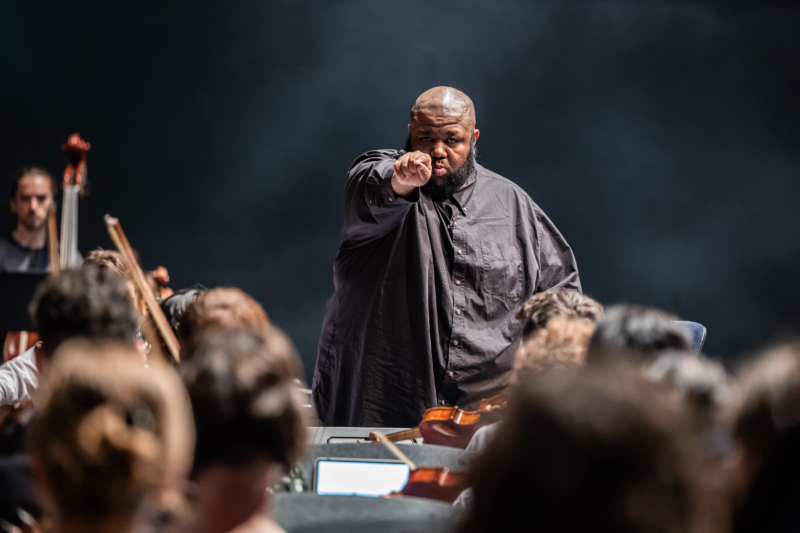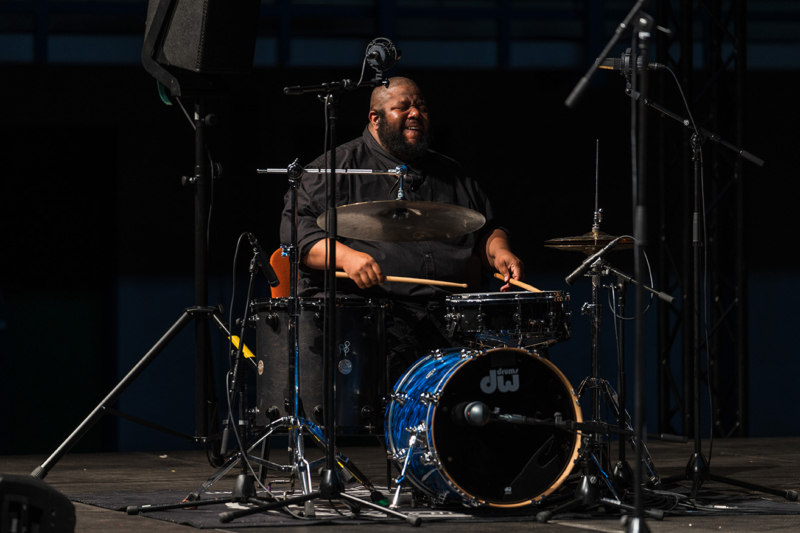READER: AUTOSCHEDIASMS
27.07.2025

Tyshawn Sorey: Autoschediasms
Presentation of the workshop with Tyshawn Sorey and Kobe Van Cauwenberghe
With participants of the Darmstadt Summer Course:
Łucja Chyrzyńska (Flute)
Albane Tamagna (Flute)
Lina Paschalia Digka (Flute)
Maya Kaya (Oboe)
Ghazal Faghihi (Clarinet)
José Nisa (Saxophone)
Martina Madini (Saxophone)
Isaac Reed (Saxophone)
Kara LaMoure (Bassoon)
Raegan Padula (Horn)
Yuval Adler (Trumpet)
Kalun Leung (Trombone)
Fanny Meteier (Tuba)
Bernardo Cruz (Percussion)
Jonas Evenstad (Percussion)
Aditya Ryan Bhat (Percussion)
Marco Abisso (E-Guitar)
Daniel Brew (E-Guitar)
Kobe Van Cauwenberghe (Guitar)
Emi See (Piano)
Yuka Funabashi (Piano)
Zach Layton (E-Piano)
Yona Su (Viola)
Ethan Chaves (Viola)
Carrie Frey (Viola)
Yifeng Yuan (Voice)
Ryan Garvey (Voice)
Sylvia Simons (Voice)
Tyshawn Sorey (Musical Direction)

INTERVIEW WITH TYSHAWN SOREY AND KOBE VAN CAUWENBERGHE
KL: What is Autoschediasms?
TS: The origin of this word is Greek and is defined as something that is “extemporaneous” or “off the cuff”. Autoschediasms has first started as a direct use and derivation of two particular spontaneous composition languages for large ensemble taught to me by two very important mentors for my development. One is “conduction”, which was invented by Lawrence Butch Morris and is a lexicon of visual cues that the conductor gives to the ensemble to perform specific actions on their instruments and to perform different kinds of music. The other is Anthony Braxton’s “language music,” for which there are twelve sound classifications.
For Autoschediasms, I added a lot of new concepts and new sets of cases for each of those two vocabularies. So it started out as a hybrid of those two languages. Then I added a third component, called “Category” which is the most complex part of this language, because not only are you given a set of parameters to function (cued using a whiteboard) but also I incorporate descriptive kinds of musical behavior that may be relative to other members of the ensemble and give the players more flexibility in their content. In addition to this, you might also see some notation on the whiteboard, like some actual music notation which may contain a set of pitches, or a key center, or a series of events that can be conducted using up to four batons. So Autoschediasms is both an affirmation of those two systems that I mentioned, but it’s also a departure from those and I have added more cases to the two aformentioned languages as they exist. And so now Autoschediasms has become its own form of spontaneous composition.
KL: So you actually have a whiteboard there and you can hande all the four batons at once?
TS: That’s right. There’s a cue called “mixer” that I use and it can apply to groups – sometimes I may divide the orchestra into, in this case, three equal groups. When I use the mixer with defined groups, a stereophonic effect is achieved, where a sound wanders through different groups and through the room. That’s only one example of several in which all four batons get used, but there are other cases too in which that happens. You can use both the whiteboard and multiple batons to indicate up to three or more different musical sound characters or music types. The four batons may be used in such a way, where one baton indicates which group, another sound, and another which series of actions are happening: sometimes any number of these may occur simultaneously or independently.
KL: Maybe you could talk a bit about your role as a conductor and also the interrelationship with the ensemble.
TS: We are very much aware that there are hierarchies that exist within not only a symphony orchestra, but also in a creative orchestra. When you’re interpreting a piece of music, you have the conductor basically directing the time, tempo, phrasing, expression and other aspects of the music. While this is similar in Autoschediasms, what I do is both generate ideas and I also allow for different things to happen – this isn’t an interpretation of notated music, but a real-time creation that is encouraged by my directives and my shaping of the overall musical form. In Autoschediasms, there is certainly a hierarchy where I am creating structure or form in the immediate moment, whereas the players are providing content suggested by me to create that form in real time. There is great responsibility and agency when it comes to performing this music: everyone, including the conductor, is responsible for the composition’s outcome.
As I have witnessed during my work with Morris and Braxton, respectively, with conduction and with language music it is imperative that the performer follows everything that the composer says and that’s how that goes. Autoschediasms, however, is more of a democratic process of music making, where for example people in the ensemble may choose to create some other kind of content that’s different from what I intended. For me, these are great opportunities: As the composer, I have to be able to make music out of it rather than view this as a mistake.
Because all too often, when I first do this with students or participants, everyone’s afraid of making mistakes and therefore the potential for what they could do gets lost. The confidence to discover and explore new ideas is not really there at all, and the music greatly will suffer. I prefer “strong and wrong” over being polite and not realizing there’s a purpose to every sound made. So I try to encourage the players that while it is important to follow all of the cues and all the gestures and different things that I assign during this process, if a mistake happens, fine. That is an opportunity to create something new and beautiful out of that mistake.
KL: This is also afforded by these concepts you added in other areas?
TS: Absolutely. It’s more flexible. There’s a lot more flexibility in terms of what can happen, content wise. I mentioned “groups” earlier, which is another Category cue. Sometimes I assign players into these groups, but for this version of Autoschediasms, I prefer to assign individuals as group “leaders” who determine who the other members of that group will be as part of their execution of material. When the musicians start creating, they’re really doing so only as a group and not necessarily as individual soloists, which is different from how individuals are cued to perform their ideas.
KL: There are internal relations with several levels of dependency to form certain structures. Nevertheless you are stated as the author of the Autoschediasms pieces.
TS: Yes, for every Autoschediasm, I view myself as the composer. What I am making with the musicians is by no means an “improvisation.” Autoschediasms is composition. In the same way that a composer who notates music has had to acquire great skill along with a deep understanding of harmony, form, melody, and rhythm, myself, along with any musician who performs in an Autoschediasm is also required to have a high level of understanding of these same musical aspects. In conduction, sound painting, language music and any other systems that are similar to this, I am by default the composer for those situations because I’m the one that’s creating the structure, based on my imagination and what I am doing with the content provided, which comes from my instructions. Such activity would not take place in the way that I’m hearing it, were the musicians to be left to their own devices. It wouldn’t be my music then, either. I’m shaping and molding the content into a through-composed coherent musical form as the performance is happening in the immediate moment. So I would say that’s correct.
KL: Kobe Van Cauwenberghe, you have been accompanying and leading this workshop these past days. What were things you were developing and working on during these couple of days?
KC: As Tyshawn just explained, the content and the creation of the material was coming from his system, Autoschediasms. Prior to starting the workshop, I facilitated and organized it so that participants were aware what was happening. During the workshop, I’ve been taking some notes, observing and sometimes giving suggestions about sound in the room. And then since yesterday, I also took up my instrument and joined the orchestra because it’s just so much fun to see them play. It’s a way of music playing that requires constant engagement, constant attention from all the players.
KL: The first step probably was to learn the language, so to speak. How long did that take?
KC: In the first session, we actually spent quite a bit of time on this. Tyshawn suggested to improvise in different subgroups to get to know each other. Because these kind of works are as much a social process: being able to communicate, to be aware of each other – feeling at ease, feeling comfortable. Within this kind of musical setting, it’s very important that everybody feels safe in a way.
That worked really well in that first session and then gradually, Tyshawn started adding more and more cues and parts of the system. And you could really feel by every day and through the musicians getting to know each other better how the response grew and how the music grew and it really became quite a strong musical collective. This is the first time this group comes together, with just four rehearsal sessions, the result is really remarkable.
KL: Have you noticed some difficulties that you faced during this process?
KC: Oh, sure. It’s quite a complex system with many layers of information. So it requires constant focus and there were many moments of confusion. But it’s always through playing that these things get resolved. Sometimes Tyshawn repeated some of the cues and we went over the material again. It was a gradual build up and a very strong group of musicians who were very eager to absorb all this information and really knew how to adapt it quite well. Of course it’s a process but it really worked very well.
KL: Tyshawn Sorey, How did you see this process of becoming a collective, of getting to know each other and also maybe overcoming these difficulties of being shy or anxious? How would you describe this process and how did you try to shape it?
TS: I would describe it as much like everyday life. This is a social music, whatever that might mean. It’s not necessarily just a social activity, but it’s like in real life when you’re having a conversation with other people that you don’t know or who you’ve met for the first time: you find a way to engage in communication, allowing for room for other people to speak, allowing for other people to respectfully communicate their musical thoughts in a space that allows for it.
What I try to do is have an environment where the overall aesthetic is egalitarian, but, you know, of course the personalities are very different. So what I have to do as the conductor, is to realize that while we have these different personalities, I want to bring out parts of those personalities that are the best parts that shine and stand out the most. My job is to create a situation where all of the members of the ensemble get to be the best versions of themselves. I try to take note of what each person can do and also become aware of what they can’t do. And I want to show the strengths of everything they have the ability to do, rather than just expose weaknesses all the time because then that doesn’t really serve anyone, you know?
Questions by Karl Ludwig
